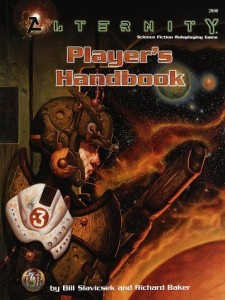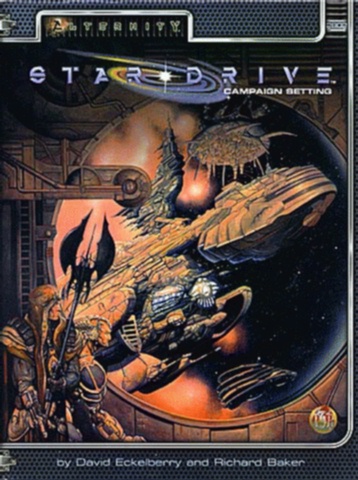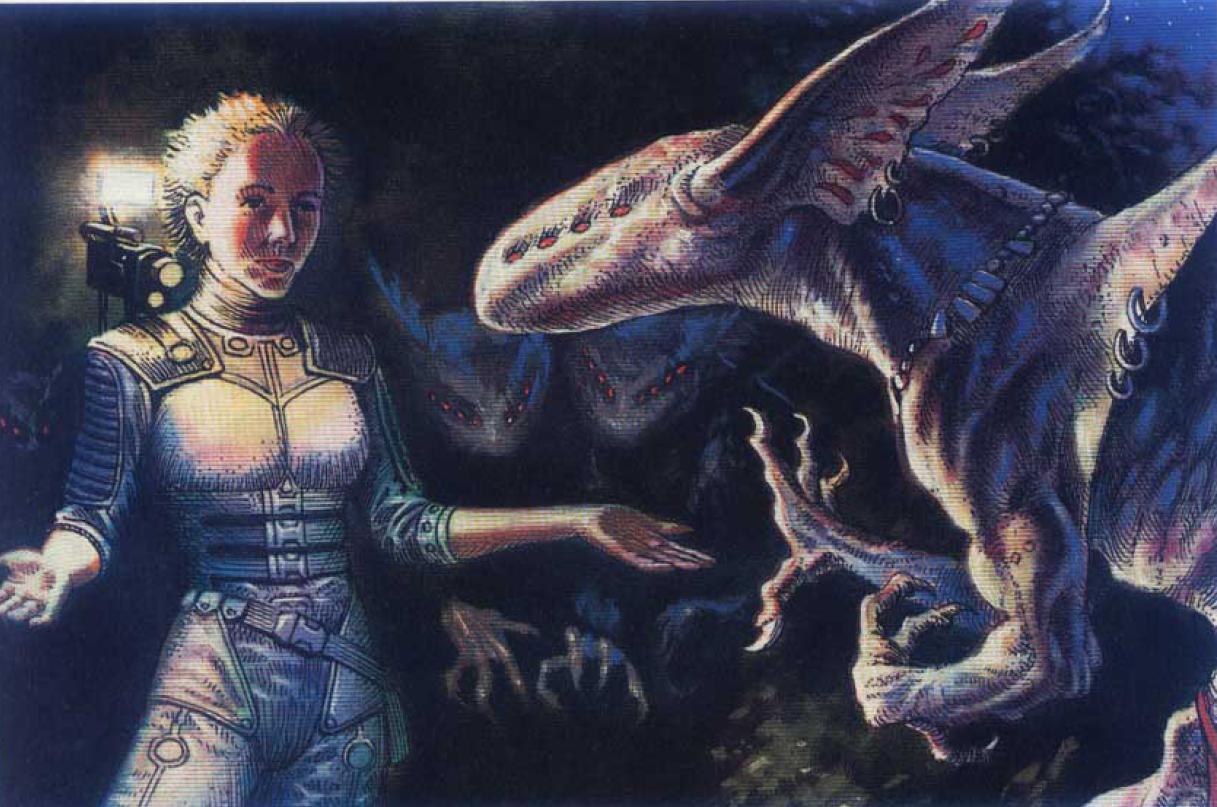 Alternity, by Bill Slavicsek and Richard Baker, is a science-fiction role-playing game released in 1998 by TSR (now Wizards of the Coast). It bills itself as “a framework for all kinds of contemporary to far-future science fiction adventures.” Indeed, its two original settings are Star*Drive, a far-future space-opera, and Dark•Matter, which is a modern-day game drawing much of its inspiration from conspiracy theories and the X-Files. It was also the game that was home to the fifth edition of Gamma World, and the Starcraft Adventures setting, which was a toned-down version of the system used for an RPG based on Blizzard Entertainment’s well-loved RTS.
Alternity, by Bill Slavicsek and Richard Baker, is a science-fiction role-playing game released in 1998 by TSR (now Wizards of the Coast). It bills itself as “a framework for all kinds of contemporary to far-future science fiction adventures.” Indeed, its two original settings are Star*Drive, a far-future space-opera, and Dark•Matter, which is a modern-day game drawing much of its inspiration from conspiracy theories and the X-Files. It was also the game that was home to the fifth edition of Gamma World, and the Starcraft Adventures setting, which was a toned-down version of the system used for an RPG based on Blizzard Entertainment’s well-loved RTS.
I consider Alternity the greatest RPG I have never played.
Frankly I’m a little afraid to play it at this point. It has taken on an almost mythic significance in my mind.
I got my hands on the Player’s Handbook back in ’98, but in typical D&D-like fashion it also required the Gamemaster Guide, which I wouldn’t pick up until some time in 2005 along with most of the other supplements from a used RPG bookshelf at my FLGS of the day.
Anyway, let’s get to the heart of the matter.
Opening File…
In order to play Alternity, you will need at least two hardcover books: the Player’s Handbook and the Gamemaster Guide as I mentioned above. If this setup sounds familiar, well, it has been a staple formula of Dungeons & Dragons and its clones for years. Once upon a time they retailed at $29.95 each, these days you can find them for a little less than that on Ebay when you can find them.
The full-color interior artwork features many excellent pieces by rk post, Todd Lockwood, and maps by Rob Lazzaretti. Although the game is intended to be capable of handling a range of times from the present to the distant star-faring future, much of the art is clearly futuristic, and the implied setting of the books as a whole was released as the Star*Drive campaign setting.
rk post’s illustrations of the alien races in the character creation chapter have stuck with me throughout the years, and probably done more to keep Alternity in my mind than anything else. There are the fraal: the classic, lanky gray aliens with big black eyes and psychic powers. You’ve got the mechalus, who are essentially humanoid circuitboards with thick strands of cable-like hair. Calling the weren “wookies with tusks” doesn’t really do justice to the sheer brutal presence that post’s art conveys on the page.
Then there are my two favorites: the bizarre, eight-eyed, bat-winged, lanky sesheyans, who vaguely resemble stealth bombers; and the t’sa, who are basically caffine-powered tech-obsessed lizardmen with impressive head frills.
But this is an RPG, not an art class!
Downloading System Data…
One thing I will never forget about Alternity is the dice. Most rolls in Alternity use two dice: a d20 called the “control die” and either a d4, d6, d8, d12, or d20 as the “situation die.” Oddly the 10-sided die is absent from the lineup. I suppose on Alternity gaming nights you could have loaned all your d10s to your friend who plays Vampire: The Masquerade.
You want to roll low. Most basic actions involve rolling d20+d4, but there can be a “step modifier” depending on the difficulty of the task at hand.
Think of the dice as a continuum, with -d20 being the easiest, and the most difficult being +Xd20, although the book suggests that more than +3d20 is so difficult you may just want to rule it as impossible.
A step modifier slides the situation die along this continuum to determine what you should roll. There’s even a d0, which is really just a placeholder to say you should roll the control die by itself. It occupies a comfortable little spot between -d4 and +d4.
You typically want to roll under your skill level. Skills are a combination of ranks and your ability score, so for instance if you have a 10 in Personality and 3 ranks in Seduce, you will want to roll under a 13.
Alternity also represents degrees of success. Each skill has thresholds. Above, your Seduce skill would look something like “Seduce 3 (13/6/3).” Rolling under a 13 means you have achieved an Ordinary success. Under 6 (one-half your score rounded down) is a Good success, and 3 (one-quarter) is Amazing. The most prevalent use of this is weapon damage, which increases in severity depending on your success, but it also matters in time-sensitive challenges and other circumstances where it’s important to know not just if someone completed a task, but how well they completed it.
This particular mechanic has always fascinated me. In the late 90s TSR was competing (though I use the term loosely) with White Wolf’s World of Darkness games, which used pools of 10-sided dice and had degrees of success based on how many successes you accumulated in a roll. I like the combination of variability and shades of performance Alternity is able to offer with only two dice.
Processing…
In 1998 the announcement of Dungeons & Dragons 3rd Edition was about to dawn. Alternity’s system greatly resembles a transition between 2nd Edition AD&D and 3E D&D mechanics, and contains the best of both worlds in a lot of ways.
It probably isn’t a coincidence that the Star Wars Roleplaying Game: Saga Edition, which came out on the eve of 3.5 and represents a phase between that and 4th Edition, was also designed by Bill Slavicsek.
It’s been 13 years, and I still haven’t played the damn thing. Part of me is afraid that after all this time the game just won’t be how I’ve envisioned it. Part of the problem is finding people who want to play something other than Dungeons & Dragons (and don’t get me wrong, I love playing D&D 4th Edition). I could sit here making excuses all day long, but I won’t. Instead I shall challenge myself: by the end of this year, I will have played at least three sessions of Alternity with friends, even if I have to drag them kicking and screaming to the table.
How about you? Will you join me? Grab the books however you can get your hands on them, and start up a game. You can find additional resources and information over at the official group, AlternityRPG.net.
Then meet me back here, and we’ll see what nostalgia has wrought.


I've loved Alternity for years, and regretted its tragic fate. That is, near-wholesale adoption into D20 Modern: Future, after being d20-ized.
I agree with your notes: the art is engaging and the degrees of success/situation die system is one that has continued to appeal to me. I've played many tabletop systems, and this weird 'proto-d20' one is my favorite. The various setting options are also handy: between Star*Drive, Gamma World, Dark • Matter, and (did you mention?) the Sliders-like semi-setting of Tangents, there's plenty of ways to play.
Other highlights to consider:
• Skills have 'rank benefits', little perks of leveling your skills; I find this far superior to D&D 3's Feat system.
• Options for Psionics, 'superhero' powers, and divine magic (if you really want it).
• Space combat and interplanetary travel.
• Progress Levels for civilizations with different levels of technology.
• Cyberware and Gridcasting (cyberdecking) for the cyberpunk in you.
Yes, I admit I was somewhat enthusiastic when I learned that much of the material had ended up in D20 Modern: Future, but when I flipped through the book at a Barnes & Noble I found myself sorely disappointed. The magic was gone, so to speak.
I'm surprised many of you seem to have the same experience with Alternity as I do! Like Voidman says, there is something about the game. Released just before the turn of the millennium, just before the transition from AD&D to 3rd Edition, rich with the creativity of TSR setting-fu.
Star*Drive really seals it for me. I've often thought about trying to write (fan)fiction set in that universe, and I must have played through hundreds of sessions in my head. Galactic trading, space stations… these are the major aspects that appeal to me.
Thanks for the other highlights, I didn't manage to get to them, and I'd forgotten all about rank benefits! I've since gone back and looked over them, and I agree they are much more interesting than 3E/3.5 feats. I do feel the divine magic was tacked on however, which is unfortunate but understandable. "How do we sell this to our AD&D players, guys?" "Throw some elves and clerics in there!"
I had always wanted to give Alternity a try and even sketched out a SF campaign setting for it. It still looks like a good game but I have never played.
My recent post New Magic Item – Skirmisher’s Shield
Oh, Alternity is a game I've wanted to play for ages, I've only played it once, but it was quite fun. I'm slowly building up the books as I find them used, I just have to find people willing to play it with me.
My recent post Let me tell you about my character Dick Chandler
Alternity is definitely one of the favourites in my collection. Likewise it holds a great sentimental value even though I never played it. There is something about this game isn’t it…
Starting with its format; two base books, so TSR-like. Clearly, they intended this to be a big, ambitious game product just like that fantasy one of theirs (well maybe slightly smaller).
I remember when I first read about it back in the ’98 it was reviewed as a SF game for those looking for an alternative to Star Wars and Star Trek. I wasn’t, but it still got me interested mainly due to its flagship StarDrive setting. Soon, I learned about the Gamma World – I was ignorantly oblivious to this esteemed game and its previous editions until then. This somewhat coincided with my Fallout crpg addiction at that time and resulted in an obsession I feel to this day. Dark Matter was just icing on the cake but being a X-files affectionado meant that I added that too to my most wanted list.
Sadly, Alternity was quite rare in my neck of the woods and a few copies I actually read, were not for sale. Unbeknown to me the game was doomed; Wizards killed the line making the books even more difficult to find. Suffice it to say, I didn’t manage to get my own back then.
Interest faded, years passed.
Now the happy end. Relatively recently, following some weird impulse (and armed with some scarce disposable income) I ended up with the base set off ebay. Who knows I may even play the game eventually when I retire ;).
Reading your review really makes me pondering whether I should get my Alternity books from my shelf, dust them off and start running a game with it. The rules are a bit more crunchy than what I usually use, but not uninteresting. And you can always ignore the crunchier bits. What really made Alternity shine were the settings. Especially Darkmatter sounds like a lot of fun.
Man, there are enough of us here who like it that we should look at setting up an online game of some sort. I would love to play in aa Star*Drive game, possibly as an idealistic combat spec from Insight….
Or as some sort of Arcane FX user in Dark*Matter- those guys looked pretty cool. I would prefer Star*Drive at this point as I have been running a lot of horror, so I would love to play a game where I get to feel like a big damn hero.
This brought back so many memories I had to write a post about my Alternity experience… Thanks for the inspiration Shaun!
I'm glad you liked it! I look forward to seeing your post!
Alternity was fantastic. I remember reading the rules and wishing D&D was so streamlined. Then 3rd edition came along. I remember reading 3E books the first times through and saying this is Alternity. It was the pre cursor to 3E. A Brilliant game!